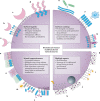Multifunctional biomolecule nanostructures for cancer therapy
- PMID: 34026278
- PMCID: PMC8132739
- DOI: 10.1038/s41578-021-00315-x
Multifunctional biomolecule nanostructures for cancer therapy
Abstract
Biomolecule-based nanostructures are inherently multifunctional and harbour diverse biological activities, which can be explored for cancer nanomedicine. The supramolecular properties of biomolecules can be precisely programmed for the design of smart drug delivery vehicles, enabling efficient transport in vivo, targeted drug delivery and combinatorial therapy within a single design. In this Review, we discuss biomolecule-based nanostructures, including polysaccharides, nucleic acids, peptides and proteins, and highlight their enormous design space for multifunctional nanomedicines. We identify key challenges in cancer nanomedicine that can be addressed by biomolecule-based nanostructures and survey the distinct biological activities, programmability and in vivo behaviour of biomolecule-based nanostructures. Finally, we discuss challenges in the rational design, characterization and fabrication of biomolecule-based nanostructures, and identify obstacles that need to be overcome to enable clinical translation.
Keywords: Cancer therapy; Nanotechnology in cancer.
© Springer Nature Limited 2021.
Conflict of interest statement
Competing interestsThe authors declare no competing interests.
Figures



References
Publication types
LinkOut - more resources
Full Text Sources
Other Literature Sources
